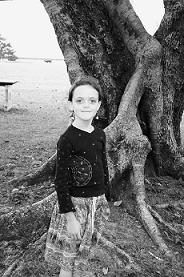Home Grown Kids: A Creative Garden

Time in the garden need not be only about planting, feeding, watering and harvesting. Another way to enjoy your garden is through art.
The garden itself is often seen as a form of art. Using plants’ colour, texture, shape and size the gardener creates a landscape of beauty. By adding accessories, either natural (such as stones) or man-made, we enhance and individualise our growing spaces. By looking at others’ gardens, parklands, nature, books and magazines from the library, and online, we can collate ideas of what appeals to us and from there gradually shape our garden through the addition of new plants or other items.
Gardening is the art that uses flowers and plants as paint, and the soil and sky as canvas. Elizabeth Murray.
Throughout history gardens have also influenced artists’ paintings, photographs and words. Famous garden artists include Paul Cezanne, Claude Monet and Georgia O’Keefe. Of course for many children, their first artworks include flowers, trees, butterflies, and other natural beauty.
Nature and the garden offer free and sustainable art supplies: flowers, leaves, gourds, bark, sticks, seeds and pods are suitable for drawing, pressing, drying, painting, decorating, paper-making, using in sculptures or useful creations, using for dying textiles and more. There are many books and websites dedicated to nature craft projects.

Designing a garden on paper, or using a computer program, is a useful creative process. A design can save you time, money and disappointment. Garden designs are a great learning tool for children too – measuring space, calculating costs and brainstorming alternatives to reduce, re-use and recycle.
Gardens are also ideal galleries. From painted flowerpots to giant-sized sculptures, imagination and creativity are at ease in any garden from window box to courtyard to farmyard… One of our vegetable gardens grows inside a greenhouse. In the greenhouse we added wind chimes, chipped crockery and mosaic items. They were clutter inside our home but provide joy out there in the jungle of greenery that is our tropical food garden.
Our daughter Imogen, loves to grow plants in pots. When she was a child, on a low, upturned broken concrete tank she had a collection of recycled containers including a fish bowl and broken teapot housing her various cacti and succulents. Her experiments with tree seedlings and strawberry runners lived amongst the exotic display. Around the base Imogen gathered her beloved potted roses, and scattered in between were rocks, shells, unfinished carving projects and more. At a glance, it was a mess, but upon closer inspection I saw her appreciation for beauty, love of nature, and artistic flair shine through. Now she lives in an apartment in inner Sydney, and she still has a house and courtyard filled with various potted plants and miscellaneous objet d'art!
Once we built a herb spiral – a pyramid-shaped pile of rocks from our creek planted with herbs grown from cuttings and seeds. The moisture-loving mint rambled at the bottom and right up top the thyme, rosemary and lavender escaped the wet soil they dislike. There was room among the herbs for some of our favourite garden art, such as pottery from the op shop which was too unusual to be practical in the kitchen, but ideal for scooping a bit of water or protecting a frog. The children added t oadstools made from clay and protected with a coat of builder’s sealing agent. There were also a few dragonflies made of bent wire and glass beads from broken costume jewellery. It was a beautiful, aromatic, useful creation.
I've always wanted to create a pond. I’ve seen simple ones built with recycled vessels or a piece of black plastic lining. By adding rocks, logs and plants of various colours and textures, the perfect environment is assembled for a few small fish. Or we might wait for the wildlife to discover this gift – frogs, birds, insects and lizards all appreciate garden ponds.

While we’re decorating for the wildlife, we might build some bird feeders together. Seed for wild birds can be purchased locally. We could also plant some of that seed and grow fresh seed heads for our feathered friends to enjoy. I’ve seen bird feeders made from fallen timber, gourds, commercial building materials and various recycled items. Various family members could try several designs to see what the birds prefer.
Some birds that visit we don’t want to encourage. Sulphur-crested Cockatoos can destroy a whole crop of fruit in one day. They often pierce a small hole in the fruit, devour the seeds, and let the rest fall, wasted, to the ground. They also bite off branches and leaves from trees in order to trim their beaks. In urban areas, they can destroy timber features of houses and fences. Once, we created a scarecrow! I noticed that when any of us were outdoors, the Cockatoos didn’t descend on the fruiting trees and vines. And those pesky crows didn’t bother our young poultry when a human (fake or real) was on guard either. A scarecrow was a fun project, and he didn't mind standing on guard in the rain!
I hope your growing space can be the muse for engaging artists of all ages.
Resources:
50 Nature Crafts for Kids
Garden Crafts for Kids: 50 Great Reasons to Get Your Hands Dirty by Diane Rhoades





